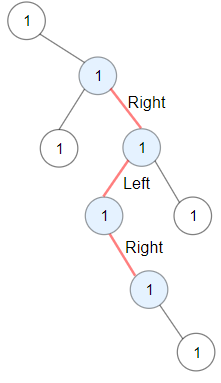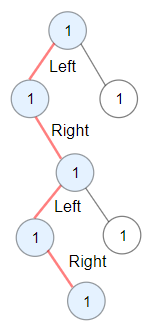- {x}
- Number of Trusted Contacts of a Customer
- How Many Numbers Are Smaller Than the Current Number
- Rank Teams by Votes
- Linked List in Binary Tree
- Minimum Cost to Make at Least One Valid Path in a Grid
- Get the Second Most Recent Activity
- Increasing Decreasing String
- Find the Longest Substring Containing Vowels in Even Counts
- Longest ZigZag Path in a Binary Tree
- Maximum Sum BST in Binary Tree
- Generate a String With Characters That Have Odd Counts
- Number of Times Binary String Is Prefix-Aligned
- Time Needed to Inform All Employees
- Frog Position After T Seconds
- Replace Employee ID With The Unique Identifier
- Find a Corresponding Node of a Binary Tree in a Clone of That Tree
- Lucky Numbers in a Matrix
- Read More...

Longest ZigZag Path in a Binary Tree
You are given the root of a binary tree.
A ZigZag path for a binary tree is defined as follow:
- Choose any node in the binary tree and a direction (right or left).
- If the current direction is right, move to the right child of the current node; otherwise, move to the left child.
- Change the direction from right to left or from left to right.
- Repeat the second and third steps until you can't move in the tree.
Zigzag length is defined as the number of nodes visited - 1. (A single node has a length of 0).
Return the longest ZigZag path contained in that tree.
Example 1:

Input: root = [1,null,1,1,1,null,null,1,1,null,1,null,null,null,1] Output: 3 Explanation: Longest ZigZag path in blue nodes (right -> left -> right).
Example 2:

Input: root = [1,1,1,null,1,null,null,1,1,null,1] Output: 4 Explanation: Longest ZigZag path in blue nodes (left -> right -> left -> right).
Example 3:
Input: root = [1] Output: 0
Constraints:
- The number of nodes in the tree is in the range
[1, 5 * 104]. 1 <= Node.val <= 100
Solution Explanation
This problem asks for the longest ZigZag path in a binary tree. A ZigZag path is defined as a path where you alternate between moving left and right children. The solution uses Depth-First Search (DFS) with a recursive helper function to efficiently find this path.
Approach:
The core idea is to track the length of ZigZag paths from each node. Instead of explicitly checking for left-right or right-left movements, we cleverly use two parameters, l and r, to represent the length of ZigZag paths ending with a left move and a right move respectively.
-
Base Case: If the current node (
root) isnull, the recursion stops, and nothing is done. -
Update Maximum Length: The maximum length encountered so far (
ans) is updated with the maximum oflandr. This represents the longest ZigZag path found up to the current node. -
Recursive Calls: Two recursive calls are made:
dfs(root.left, r + 1, 0): If we move to the left child, we increment ther(right-ending path length) because the previous move was to the right, and thel(left-ending path length) is reset to 0.dfs(root.right, 0, l + 1): If we move to the right child, we incrementl(left-ending path length) as the previous move was to the left andris reset.
Time Complexity: O(N), where N is the number of nodes in the tree. The DFS visits each node exactly once.
Space Complexity: O(H), where H is the height of the tree. This accounts for the recursive call stack space in the worst-case scenario of a skewed tree. In a balanced tree, this becomes O(log N).
Code Explanation (Python3 Example)
class Solution:
def longestZigZag(self, root: TreeNode) -> int:
def dfs(root, l, r):
if root is None:
return
nonlocal ans
ans = max(ans, l, r)
dfs(root.left, r + 1, 0)
dfs(root.right, 0, l + 1)
ans = 0
dfs(root, 0, 0)
return ansans: A global variable to keep track of the maximum ZigZag path length.dfs(root, l, r): The recursive helper function.root: The current node being processed.l: Length of the ZigZag path ending with a left move.r: Length of the ZigZag path ending with a right move.
- The
nonlocal ansstatement ensures that we are modifying the globalansvariable, not creating a local copy. - The base case checks if the current node is
None. - The recursive calls explore the left and right subtrees, updating
landrappropriately.
The other languages (Java, C++, Go) follow the same logic and algorithmic structure, merely differing in syntax. They all leverage a recursive DFS approach to efficiently compute the longest ZigZag path length.